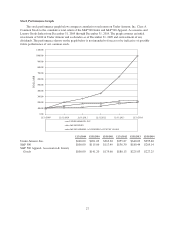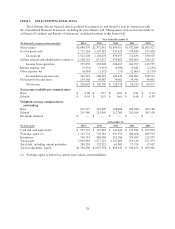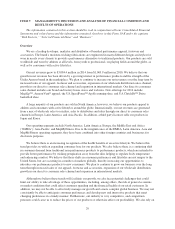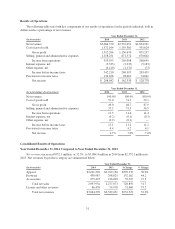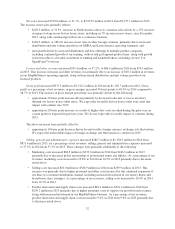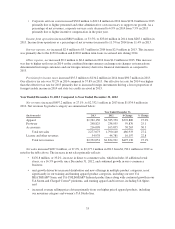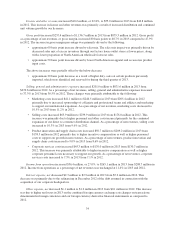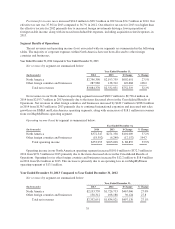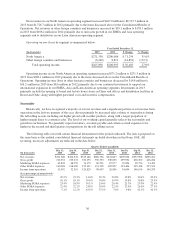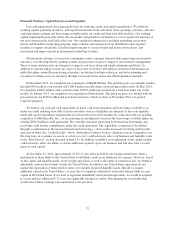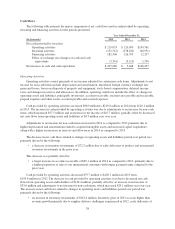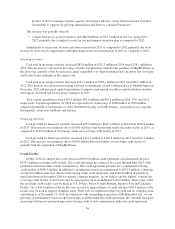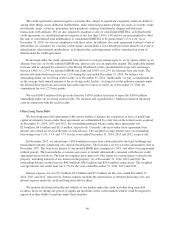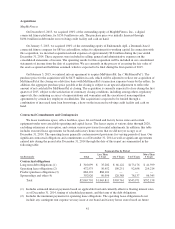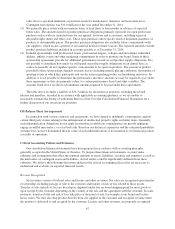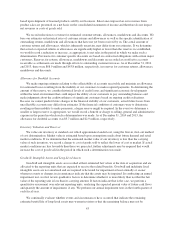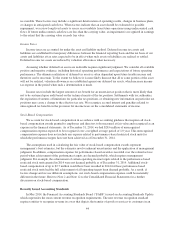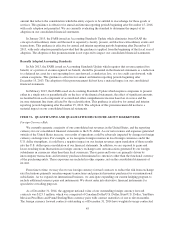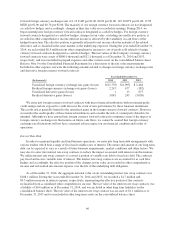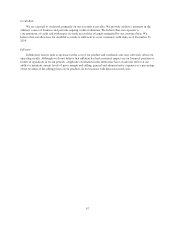Under Armour 2014 Annual Report Download - page 47
Download and view the complete annual report
Please find page 47 of the 2014 Under Armour annual report below. You can navigate through the pages in the report by either clicking on the pages listed below, or by using the keyword search tool below to find specific information within the annual report.F
i
nanc
i
al Pos
i
t
i
on,
C
a
pi
tal Resources and L
iq
u
i
d
i
t
y
Our cash requirements have principally been for working capital and capital expenditures. We fund our
working capital, primarily inventory, and capital investments from cash flows from operating activities, cash and
cash equivalents on hand and borrowings available under our credit and long term debt facilities. Our workin
g
capital requirements generally reflect the seasonality and growth in our business as we recognize the majority o
f
o
ur net revenues in the back half of the year. Our capital investments have included expanding our in-store
f
ixture and branded concept shop program, improvements and expansion of our distribution and corporat
e
f
acilities to support our growth, leasehold improvements to our new brand and factory house stores, and
investment and improvements in information technology systems
.
Our inventory strategy is focused on continuing to meet consumer demand while improving our inventor
y
efficiency over the long term by putting systems and processes in place to improve our inventory management.
T
hese systems and processes are designed to improve our forecasting and supply planning capabilities. I
n
addition to systems and processes, key areas of focus that we believe will enhance inventory performance ar
e
added discipline around the purchasing of product, production lead time reduction, and better planning and
execution in selling of excess inventory through our factory house stores and other liquidation channels.
I
n December 2013, we completed our acquisition of MapMyFitness. The purchase price was initially funded
through
$
50.0 million cash on hand and
$
100.0 million in debt under our revolving credit facility. In May 2014
,
we re
p
aid the
$
100.0 million with a
p
ortion of the
$
150.0 million
p
roceeds from a term loan under our credit
f
acility. In January 201
5
, we completed our acquisition of Endomondo. The purchase price was funded with th
e
p
roceeds from our
$
100.0 million delayed draw term loan, which we drew in November 2014, for genera
l
cor
p
orate
p
ur
p
oses.
We believe our cash and cash equivalents on hand, cash from operations and borrowings available to us
under our credit and long term debt facilities and other sources of liquidity are adequate to meet our liquidit
y
needs and capital expenditure requirements for at least the next twelve months. In connection with our pending
acquisition of MyFitnessPal, Inc., we are pursuing an amendment to increase the borrowings available under our
existing
$
650.0 million credit agreement. We currently anticipate increasing both term loan borrowings an
d
r
evolving credit facility commitments under the credit agreement. The acquisition is expected to be funded
through a combination of the increased term loan borrowings, a draw on the increased revolving credit facility
and cash on hand. See “Credit Facility” below. Although we believe we have adequate sources of liquidity over
the long term, an economic recession or a slow recovery could adversely affect our business and liquidity (refer
to the “Risk Factors” section included in Item 1A). In addition, instability in or tightening of the capital markets
could adversely affect our ability to obtain additional capital to grow our business and will affect the cost and
terms of such ca
p
ital
.
A
t December 31, 2014, approximately 21.8% of our cash was held by our foreign subsidiaries where
a
r
epatriation of those funds to the United States would likely result in an additional tax expense. However, based
o
n the capital and liquidity needs of our foreign operations, as well as the status of current tax law, we intend to
indefinitely reinvest these funds outside the United States. In addition, our United States operations do no
t
r
equire the repatriation of these funds to meet our currently projected liquidity needs. Should we requir
e
additional capital in the United States, we may elect to repatriate indefinitely reinvested foreign funds or raise
capital in the United States. If we were to repatriate indefinitely reinvested foreign funds, we would be require
d
to accrue and pay additional U.S. taxes less applicable foreign tax credits. Determining the tax liability that
would arise if these earnings were repatriated is not practical.
3
7


